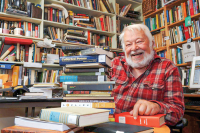Reducing their footprint: Smokies unveils new energy-efficient equipment
 The Great Smoky Mountains National Park marked a milestone last week with the unveiling of 10 new pieces of equipment to make transportation in the park more energy-efficient.
The Great Smoky Mountains National Park marked a milestone last week with the unveiling of 10 new pieces of equipment to make transportation in the park more energy-efficient.
A project four years in the making, the new purchases — made using a $239,000 grant — are just the first phase in a three-year plan to reduce emissions in the park.
“The Park is a clean transportation leader within the National Park Service and is setting a great example for other parks and fleets across the nation,” said Bill Eaker, coordinator of the Land of Sky Regional Council Clean Vehicles Coalition. “We are thrilled to be a part of this partnership.”
Eaker is all about clean air and water, a familiar face at any table around which environmental planning efforts are discussed in the Land of Sky’s jurisdiction. So it’s probably no surprise that when the U.S. Department of Energy launched its National Parks Initiative in 2010, Eaker — together with his counterpart in East Tennessee, East Tennessee Clean Fuels Director Jonathan Overly — was quick to sell the Smokies on it. The initiative provides $1 million in funding annually to projects in national parks that help reduce emissions and use alternative fuels.
“The Smokies had been working with us to secure some funds from the Department of Energy to begin that process,” Eaker said.
The park had already made some environmental upgrades before the DOE program came along. In 2007, it converted two-dozen diesel vehicles to run on biodiesel, using a Clean Fuel Advanced Technology grant secured by Friends of the Smokies, and matching funds from the Friends of the Smokies license plate program. In 2008 the park received two new electric vehicles through funds from the Clean Fuels Advance Technology Program and Friends of the Smokies. A 2010 N.C. Department of Transportation grant allowed the park to purchase seven hybrid vehicles.
Related Items
But the park wanted to do more. With help from Eaker and Overly, it put together a three-year project proposal under the program. The recently unveiled equipment represents year one.
Now, the park has five gasoline mowers converted to run on propane, a cheaper and cleaner-burning fuel than gasoline. The money also paid for three low-speed electric vehicles for use in campground areas like Elkmont and Smokemont, as well as Cade’s Cove — the vehicles get the equivalent of 100 miles per gallon.
The component of the project that Eaker is most proud of, though, is the electric recharging stations installed at Sugarlands and Oconaluftee visitor centers. Each visitor center now has both a Level 2, or medium speed, charging station and a D.C. fast-charging station.
“The Smokies is the first national park in the country to install these fast chargers,” Eaker said. “We’re a little proud of that accomplishment.”
Together, these improvements will help the park reduce its greenhouse gas emissions by nearly 40 million tons of carbon dioxide annually, according to the DOE.
“Putting this equipment in use will help us meet our goal of reducing our greenhouse gas emissions from 2006 levels by 20 percent by 2020, and you will hear more from us in 2016 — the 100th anniversary of the National Park System — on our continued efforts towards this goal,” said Smokies Superintendent Cassius Cash.
The effort won’t stop with the recently purchased equipment. Funding has already been approved for year two of the plan, and the park intends to apply for a third year of funding as well. It will also be looking to other funding sources.
Eaker’s been working with other national parks to use the program, too. The Blue Ridge Parkway already has four propane-powered Ford 520 pickups, as well as four Ford hybrid cars. He’s also helped the Carl Sandburg Historic Home in Flat Rock put in a proposal to convert some vehicles to propane.
It’s been a long road, he said, but the payoff will be worth it.
“That’s going to reduce emissions in the park and air pollution and reduce our greenhouse gases and help with climate change, and it will just make a much nicer experience for the visitor because these electric cars are very quiet,” he said. “Traffic in the park creates a lot of noise.”









